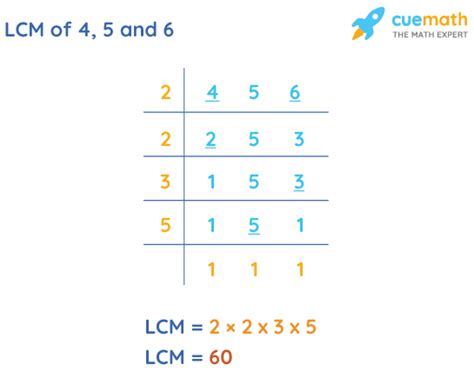Lcm Of 4 And 5 And 6
News Co
Apr 08, 2025 · 4 min read

Table of Contents
Finding the Least Common Multiple (LCM) of 4, 5, and 6: A Comprehensive Guide
Finding the Least Common Multiple (LCM) is a fundamental concept in mathematics with wide-ranging applications, from scheduling problems to simplifying fractions. This article will delve into the process of calculating the LCM of 4, 5, and 6, exploring multiple methods and providing a deeper understanding of the underlying principles. We'll also touch upon the significance of LCMs and their practical uses.
Understanding Least Common Multiples (LCM)
Before we jump into the calculation, let's clarify what an LCM actually is. The Least Common Multiple of two or more numbers is the smallest positive integer that is divisible by all the numbers without leaving a remainder. Think of it as the smallest number that contains all the given numbers as factors.
For example, let's consider the numbers 2 and 3. Multiples of 2 are 2, 4, 6, 8, 10, 12... Multiples of 3 are 3, 6, 9, 12, 15... The smallest number that appears in both lists is 6. Therefore, the LCM of 2 and 3 is 6.
Methods for Calculating the LCM of 4, 5, and 6
Several methods can be used to determine the LCM of 4, 5, and 6. We will explore the most common and efficient approaches:
1. Listing Multiples Method
This is a straightforward method, especially for smaller numbers. We list the multiples of each number until we find the smallest multiple common to all three:
- Multiples of 4: 4, 8, 12, 16, 20, 24, 28, 32, 36, 40, 44, 48, 52, 56, 60...
- Multiples of 5: 5, 10, 15, 20, 25, 30, 35, 40, 45, 50, 55, 60...
- Multiples of 6: 6, 12, 18, 24, 30, 36, 42, 48, 54, 60...
By examining the lists, we can see that the smallest number common to all three lists is 60. Therefore, the LCM(4, 5, 6) = 60. This method becomes less efficient as the numbers get larger.
2. Prime Factorization Method
This method is more systematic and efficient, especially for larger numbers. It involves finding the prime factorization of each number and then constructing the LCM using the highest powers of each prime factor.
- Prime factorization of 4: 2²
- Prime factorization of 5: 5
- Prime factorization of 6: 2 x 3
To find the LCM, we take the highest power of each prime factor present in the factorizations:
- The highest power of 2 is 2² = 4
- The highest power of 3 is 3¹ = 3
- The highest power of 5 is 5¹ = 5
Now, we multiply these highest powers together: 4 x 3 x 5 = 60. Therefore, the LCM(4, 5, 6) = 60.
3. Greatest Common Divisor (GCD) Method
This method utilizes the relationship between the LCM and the Greatest Common Divisor (GCD) of two numbers. The formula is:
LCM(a, b) x GCD(a, b) = a x b
We can extend this to three numbers by finding the LCM of the LCM of two numbers and the third number.
First, let's find the GCD of 4 and 5 using the Euclidean algorithm:
- 5 = 1 x 4 + 1
- 4 = 4 x 1 + 0
The GCD(4, 5) = 1. Now, we can find the LCM(4, 5):
LCM(4, 5) = (4 x 5) / GCD(4, 5) = 20 / 1 = 20
Next, we find the GCD of 20 and 6:
- 20 = 3 x 6 + 2
- 6 = 3 x 2 + 0
GCD(20, 6) = 2. Finally, we calculate the LCM(20, 6):
LCM(20, 6) = (20 x 6) / GCD(20, 6) = 120 / 2 = 60
Therefore, LCM(4, 5, 6) = 60. While this method involves multiple steps, it demonstrates a powerful connection between LCM and GCD.
Applications of LCM
The concept of LCM has numerous applications across various fields:
1. Scheduling Problems
Imagine you have three different machines that complete a cycle in 4, 5, and 6 hours, respectively. To determine when all three machines will complete a cycle simultaneously, we need to find the LCM of 4, 5, and 6, which is 60. All three machines will complete a cycle together after 60 hours.
2. Fraction Addition and Subtraction
When adding or subtracting fractions with different denominators, finding the LCM of the denominators is crucial. This LCM becomes the least common denominator (LCD), simplifying the process of finding a common denominator before performing the arithmetic operation.
3. Music Theory
In music, LCMs are used in calculating rhythmic patterns and finding the least common denominator of various time signatures.
4. Gear Ratios
In mechanical engineering, the LCM is used in calculating gear ratios and determining the optimal gear combinations for specific applications.
Conclusion: Mastering LCM Calculations
Calculating the Least Common Multiple is a fundamental skill with wide-ranging applications. We've explored three different methods: listing multiples, prime factorization, and using the GCD. The prime factorization method is generally preferred for its efficiency, especially when dealing with larger numbers. Understanding LCM not only enhances mathematical proficiency but also opens doors to solving practical problems in various fields, from scheduling to engineering. By mastering these techniques, you'll be better equipped to tackle more complex mathematical problems and real-world applications involving LCM calculations. Remember to always choose the method that best suits the numbers involved and your comfort level. Practice makes perfect, so try calculating the LCMs of different sets of numbers to solidify your understanding.
Latest Posts
Related Post
Thank you for visiting our website which covers about Lcm Of 4 And 5 And 6 . We hope the information provided has been useful to you. Feel free to contact us if you have any questions or need further assistance. See you next time and don't miss to bookmark.